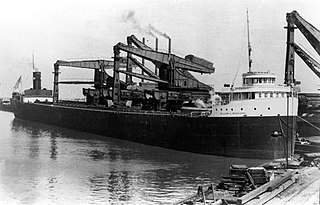
The SS William G. Mather is a retired Great Lakes bulk freighter now restored as a museum ship in Cleveland, Ohio, one of five in the Great Lakes region. She transported cargo such as ore, coal, stone, and grain to ports throughout the Great Lakes, and was nicknamed "The Ship That Built Cleveland" because Cleveland's steel mills were a frequent destination.
The Defoe Shipbuilding Company was a small ship builder established in 1905 in Bay City, Michigan, United States. It ceased to operate in 1976 after failing to renew its contracts with the United States Navy. The site of the former company is now being developed for business and housing on the bank of the Saginaw River.

The SS James Carruthers was a Canadian Great Lakes freighter built in 1913. The ship was owned by the St. Lawrence & Chicago Steam and Navigation Company of Toronto, Ontario, with the official registry number 131090.

The Mississagi was a lake freighter launched in 1943. Originally she was powered by a 2,500 horsepower (1,900 kW) triple-expansion steam engine. In 1985 her steam engines were replaced by a 4,500 horsepower (3,400 kW) diesel engine.
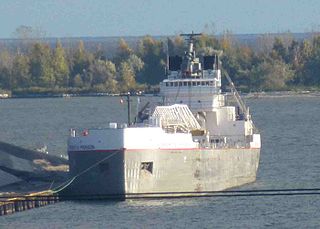
The Robert S. Pierson is a bulk carrier built for and operated on the North American Great Lakes.

The SS St. Marys Challenger is a freight-carrying vessel operating on the North American Great Lakes built in 1906. Originally an ore boat, she spent most of her career as a cement carrier when much larger ore boats became common. After a 107-year-long working career as a self-propelled boat, she was converted into a barge and paired with the tug Prentiss Brown as an articulated tug-barge. Before conversion, she was the oldest operating self-propelled lake freighter on the Great Lakes, as well as being one of the last freight-carrying vessels on the Great Lakes to be powered by steam engines.

Howard M. Hanna Jr. was a 500 ft (150 m) Great Lakes freighter that had a lengthy, 75-year career on the Great Lakes of Canada and America. Hanna was a product of the Cleveland Shipbuilding Company of Cleveland, Ohio. The ship was commissioned by the Richardson Transportation Company to haul iron ore, coal and grain. She had a cargo capacity of 9,200 tons of bulk cargo, or 323,000 bushels of grain.

Augustus B. Wolvin was a 560 ft (170 m) long Great Lakes freighter that had a 63-year career on the Great Lakes. Augustus B. Wolvin was a product of the American Shipbuilding Company of Cleveland, Ohio. She was built for the Acme Steamship Company of Duluth, Minnesota.

The SS William G. Mather was a 533-foot (162 m) long Great Lakes freighter that was built in 1905, by the Great Lakes Engineering Works (GLEW) of Ecorse, Michigan, for the Grand Island Steamship Company. Her keel was laid on May 18, 1905. She was launched on September 23, 1905, as hull #9. The ship was named after William G. Mather, the Cleveland-Cliffs executive. She was powered by a 2,000-horsepower (1,500 kW) triple expansion steam engine which was attached to a single fixed-pitch propeller. She was fueled by two coal-fired Scotch marine boilers.
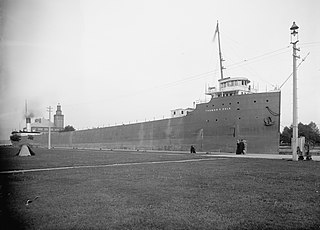
The SS Thomas F. Cole was a 605.6 ft (184.6 m) long Great Lakes freighter built in 1907 for the Pittsburgh Steamship Company by the Great Lakes Engineering Works of Ecorse, Michigan. The boat was named after mining mogul Thomas F. Cole. She was launched as hull #27 on January 26, 1907. She was powered by a 2,000 horsepower triple expansion steam engine which was attached to a single fixed pitch propeller. She was powered by two coal-fired scotch marine boilers. She had a top speed of ten knots. She entered service on May 26, 1907. She arrived for her first load of iron ore on May 29, 1907.

Howard L. Shaw was a 451-foot (137 m) long propeller driven freighter that operated on the Great Lakes of North America from her launching in 1900 to her retirement 1969. She is currently serving as a breakwater in Ontario Place on Lake Ontario.

The Frank C. Ball was an American Bulk carrier that was built by the Great Lakes Engineering Works of Ecorse, Michigan, for the Globe Steamship Company of Duluth, Minnesota. She was launched on December 9, 1905, as hull #14. She was powered by a 1,700 horsepower triple expansion steam engine and fueled by two coal-fired Scotch marine boilers. Even though Ball was built in 1905, she only entered service in 1906.
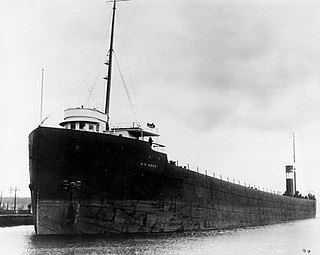
The H.P. Bope was an American steel-hulled, propeller-driven Great Lakes freighter built in 1907 by the Superior Shipbuilding Company of Superior, Wisconsin for service on the Great Lakes of North America. She was used to transport bulk cargoes such as coal, iron ore and grain.
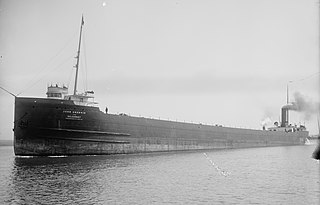
The John Sherwin was an American steel-hulled, propeller-driven Great Lakes freighter built in 1906 by the West Bay City Shipbuilding Company of Bay City, Michigan for service on the Great Lakes of North America. She was used to transport bulk cargoes such as coal, iron ore and grain. She served from her launching in 1906 to her scrapping in 1974, in Germany.

The J.H.G. Hagarty was a 550-foot (170 m) Canadian Great Lakes freighter that served from her launching in 1914 to her scrapping in 1968. The Hagarty was used to haul bulk cargoes such as iron ore, coal, grain and occasionally limestone. She had a length of 550-feet, a beam of 58-feet and a height of 31-feet. She was powered by a 2,400 horsepower triple expansion steam engine and fueled by two coal-fired Scotch marine boilers.

SS Willis L. King was a 600-foot-long (180 m), steel-hulled, propeller-driven American Great Lakes freighter built in 1911 by the Great Lakes Engineering Works of Ecorse, Michigan. She was scrapped in 1984 in Ashtabula, Ohio. Willis L. King is best known for her collision with the steamer Superior City on August 20, 1920, in Whitefish Bay.
Overlakes Freight Corporation was shipping agent company founded in New York City on April 21, 1932, by William M. Nicholson. Overlakes Freight Corporation operated Liberty Ships during and for post World War II efforts. Most of Overlakes Freight Corporation ships were purchased by the War Shipping Administration for the war. Nicholson also owned the Nicholson Universal Steamship Company, Nicholson, Erie, Dover, Ferry Line, Nicholson Terminal & Dock Company, Aqua Terminal & Dock Corporation and the Nicholson Transit Company.







